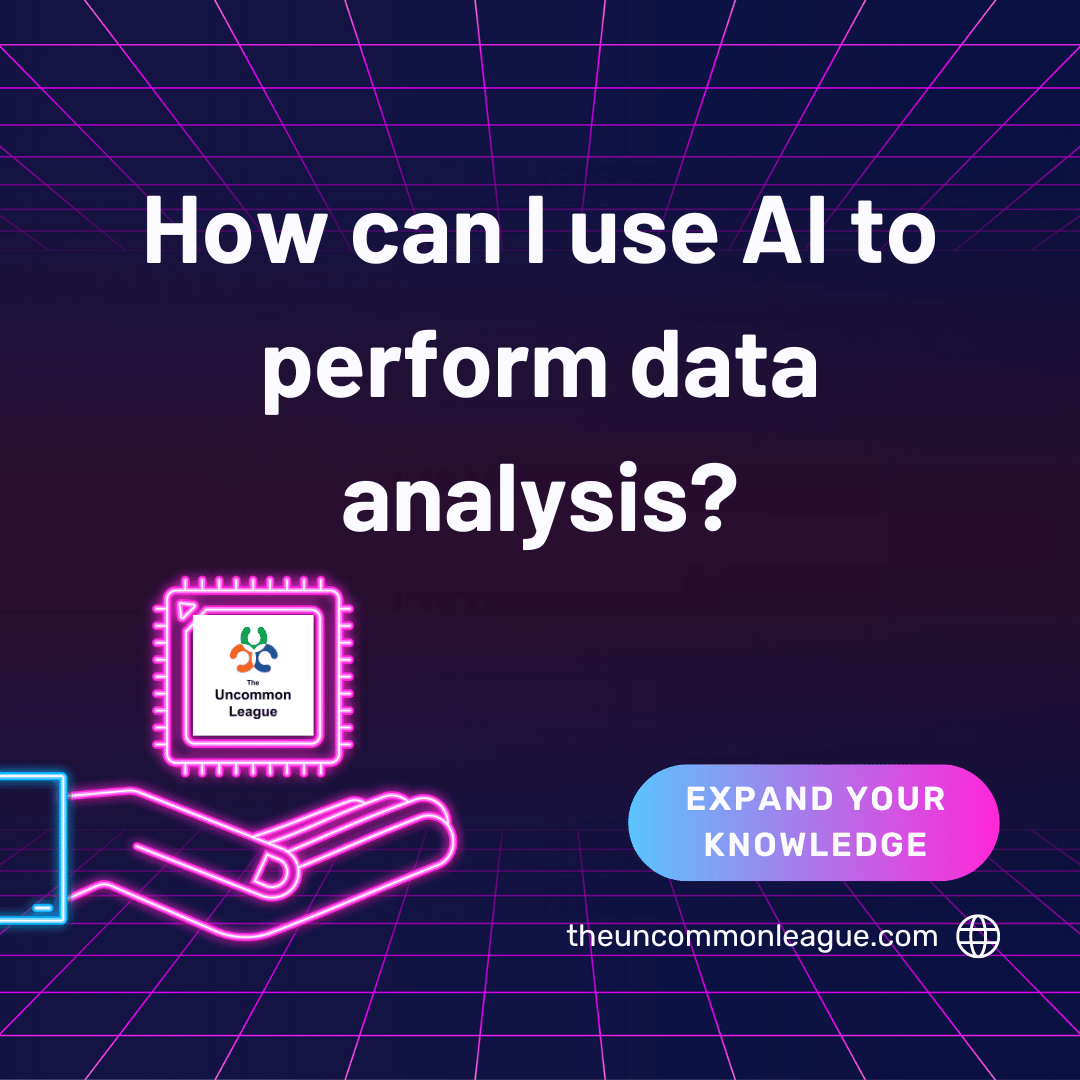How can I use AI to perform data analysis?
In today's data-driven world, the ability to extract actionable insights from vast amounts of information is critical for success in both business and research. With the emergence of artificial intelligence (AI) technologies, data analysis has been revolutionized, offering powerful tools and techniques to uncover patterns, trends, and correlations in complex datasets. From machine learning algorithms to natural language processing techniques, AI has transformed the landscape of data analysis, enabling organizations and individuals to derive deeper insights and make more informed decisions. In this article, we explore how AI can be leveraged to perform data analysis, taking into consideration current trends and cutting-edge tools.
Understanding the Role of AI in Data Analysis
Before delving into specific strategies and tools, it's essential to understand the role of AI in data analysis. AI encompasses a range of technologies and techniques that enable machines to mimic human cognitive functions such as learning, reasoning, and problem-solving. In the context of data analysis, AI algorithms can automate repetitive tasks, identify patterns in data, and make predictions based on historical trends. By leveraging AI, organizations can extract valuable insights from data more efficiently and effectively than ever before.
Automated Data Processing: AI algorithms can automate the process of data cleaning, preprocessing, and transformation, enabling organizations to prepare large datasets for analysis quickly and accurately. By leveraging techniques such as natural language processing (NLP) and computer vision, AI systems can interpret unstructured data formats such as text and images, extracting relevant information and converting it into structured data for analysis.
Pattern Recognition and Prediction: AI algorithms, particularly those based on machine learning techniques such as supervised learning and unsupervised learning, can identify patterns, trends, and correlations in data. By analyzing historical data and identifying underlying relationships, AI systems can make predictions about future outcomes, enabling organizations to anticipate market trends, customer behavior, and potential risks.
Natural Language Processing (NLP) for Text Analysis: NLP techniques enable AI systems to analyze and understand human language, making it possible to extract insights from textual data such as emails, social media posts, and customer reviews. By leveraging NLP algorithms, organizations can perform sentiment analysis, topic modeling, and entity recognition to gain valuable insights into customer opinions, market trends, and competitor strategies.
Current Trends in AI-driven Data Analysis
To effectively leverage AI for data analysis, it's crucial to stay informed about the latest trends shaping this field. Several trends are driving advancements in AI-driven data analysis and influencing how organizations extract insights from data:
Augmented Analytics: Augmented analytics combines AI and machine learning techniques with traditional analytics tools to automate data preparation, analysis, and visualization. By leveraging augmented analytics platforms, organizations can uncover insights from data more quickly and easily, enabling decision-makers to make more informed decisions.
Explainable AI (XAI): As AI algorithms become more complex and pervasive, there's a growing emphasis on explainability and transparency. Explainable AI (XAI) techniques aim to make AI-driven data analysis processes interpretable to humans, enabling users to understand how insights are generated and assess their reliability.
Automated Machine Learning (AutoML): Automated machine learning platforms enable organizations to automate the process of building, training, and deploying machine learning models. By streamlining the machine learning pipeline, AutoML platforms make it easier for organizations to leverage AI for data analysis, even without extensive expertise in machine learning techniques.
AI-powered Business Intelligence (BI): AI-powered BI platforms combine advanced analytics with natural language processing and machine learning capabilities to deliver actionable insights and recommendations. These platforms leverage AI algorithms to automate data analysis, identify trends, and generate insights, enabling decision-makers to make informed decisions quickly and effectively.
Strategies for Using AI in Data Analysis
Now that we've explored the role of AI in data analysis and current trends in the field, let's discuss actionable strategies for leveraging AI to perform data analysis effectively:
Identify Data Analysis Goals: Clearly define the goals and objectives of your data analysis project, including the types of insights you hope to uncover and the questions you want to answer. By establishing clear objectives, you can focus your efforts on relevant data analysis tasks and ensure that AI algorithms align with your goals.
Select Appropriate AI Techniques: Choose AI techniques and algorithms that are suitable for the data analysis task at hand. Depending on the nature of the data and the insights you want to uncover, consider using techniques such as machine learning, natural language processing, or computer vision.
Prepare and Cleanse Data: Ensure that your data is clean, consistent, and free from errors before performing analysis. Use AI algorithms to automate the process of data cleaning, preprocessing, and transformation, saving time and minimizing errors associated with manual data preparation.
Visualize and Interpret Results: Visualize the results of your data analysis using charts, graphs, and dashboards to make insights more accessible and understandable. Interpret the results in the context of your business objectives and domain expertise, considering the implications for decision-making and strategy.
Iterate and Refine Analysis: Continuously iterate and refine your data analysis approach based on feedback, insights, and emerging trends. Experiment with different AI techniques and algorithms to uncover new insights and optimize decision outcomes over time.
Tools for AI-driven Data Analysis
A variety of tools and platforms are available to support AI-driven data analysis across different domains and industries. These tools offer capabilities for data preprocessing, modeling, visualization, and deployment:
Machine Learning Frameworks: Machine learning frameworks such as TensorFlow, PyTorch, and Scikit-learn provide libraries and tools for building, training, and deploying machine learning models. These frameworks support a wide range of algorithms and techniques, enabling organizations to leverage AI for predictive modeling and pattern recognition.
April 15 - 17, 2024 (3 Days)
9:00 am (Central) until 5:00pm (Central)
Online - Live Instructor
Natural Language Processing (NLP) Libraries: NLP libraries such as NLTK, SpaCy, and Gensim offer tools and algorithms for analyzing and processing textual data. These libraries enable organizations to perform tasks such as sentiment analysis, named entity recognition, and text summarization, unlocking valuable insights from unstructured text.
Data Visualization Tools: Data visualization tools like Tableau, Power BI, and Plotly enable organizations to create interactive charts, graphs, and dashboards to visualize and explore data. These tools make it easy to communicate insights and findings from data analysis, enabling decision-makers to understand complex patterns and trends at a glance.
Automated Machine Learning (AutoML) Platforms: Automated machine learning platforms such as Google AutoML, DataRobot, and H2O.ai enable organizations to automate the process of building and deploying machine learning models. These platforms streamline the machine learning pipeline, making it easier for organizations to leverage AI for data analysis without extensive expertise in machine learning techniques.
Data Analysis + AI
AI-driven data analysis represents a paradigm shift in how organizations extract insights from data, enabling more efficient, accurate, and actionable analysis than ever before. By understanding the role of AI in data analysis, staying informed about current trends, and leveraging the right tools and strategies, individuals and organizations can unlock the full potential of AI to extract valuable insights from data and drive informed decision-making. As AI continues to evolve, embracing innovation and adopting a data-driven approach will be essential for staying competitive and driving success in the digital age.
Tags #businessanalysis #ai


